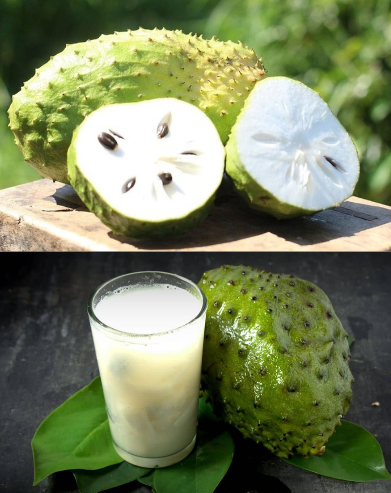
Have you ever tasted something that feels like a tropical vacation in your mouth? That’s soursop for you. Known by many names—Graviola, Guanabana, or simply sour sop—this prickly green fruit with creamy white flesh is a powerhouse of flavor, nutrients, and natural wellness. It’s like if pineapple, strawberry, and citrus had a smoothie baby—add a custard-like texture and you’ve got nature’s sorbet.
But soursop isn’t just a fruit you toss in a blender and forget. It’s a cultural staple, a traditional remedy, and a delicious mystery waiting to be explored. Let’s break down what makes this tropical gem so special, how to eat it, and why it deserves a spot in your kitchen.
What Is Soursop? The Fruit with Many Faces
Soursop is the fruit of the Annona muricata tree, found in tropical regions across the Caribbean, Central America, Southeast Asia, and parts of Africa. It’s got a wild appearance—green and spiky on the outside, but soft, white, and fragrant on the inside. The flavor? Imagine if strawberry, banana, and pineapple merged into one juicy bite. It’s sweet, a little tangy, and completely addictive.
People have been enjoying this fruit for generations, not just for its taste but for its health benefits. From traditional tea remedies made with its leaves to smoothies and desserts made with the pulp, soursop is both medicine and indulgence.
Step-by-Step: How to Eat Soursop Like a Pro
First things first: if you’ve never cracked open a soursop before, don’t worry—it’s easier than it looks. Here’s a simple step-by-step guide to enjoying this fruit at its best.
What You’ll Need
- 1 ripe soursop (soft to the touch with a fruity aroma)
- A knife
- A spoon or just your clean hands
Let’s Dig In
- Wash the fruit thoroughly to remove any dirt or pesticide residue.
- Cut it in half lengthwise. You’ll see the creamy pulp and black seeds inside.
- Scoop out the white flesh using a spoon—or just use your hands if you’re going rustic.
- Remove the seeds as you go. They’re large, hard, and not edible.
- Enjoy the pulp fresh, or use it in a smoothie, juice, or dessert.
It’s that simple. No fancy tools required—just you, your fruit, and a little bit of curiosity.
Video : SourSop Fruit – How to Eat Soursop – SourSop – Sour Sop – Graviola
Creative Ways to Enjoy Soursop
This fruit doesn’t just shine on its own—it plays well with others. Here are a few delicious ways to take your soursop experience to the next level:
Soursop Smoothie
Blend the pulp with a splash of coconut milk, ice cubes, and a dash of honey. You’ll get a smoothie so creamy and tropical, it feels like you’re sipping it poolside.
Refreshing Soursop Juice
Toss the pulp in a blender with water. Strain out the seeds and fiber, chill it, and enjoy a naturally sweet juice that beats any store-bought beverage.
Homemade Sorbet or Ice Cream
Freeze the pulp, then blend it with lime juice and a drizzle of honey. You’ve just made a dairy-free dessert that rivals anything in the freezer aisle.
Traditional Soursop Leaf Tea
Not into sweets? Soursop leaves have been used for centuries in teas believed to help with sleep, stress, and immune support. Just steep the dried leaves in hot water for 10–15 minutes.
Important Note on Safety
Soursop is packed with natural goodness, but a little knowledge goes a long way:
- Do not eat the seeds. They contain compounds that may be harmful in large quantities. Always remove them.
- Moderation is key. Whether you’re eating the fruit or drinking the tea, avoid overdoing it—especially if you’re pregnant or have health concerns. When in doubt, talk to a doctor or nutritionist.
Why Soursop Is Good for You
Okay, it’s delicious—but is it actually good for your body? Oh yes. Here’s what soursop brings to the table:
- High in Vitamin C – A single serving boosts your immune system and helps fight off infections.
- Packed with Antioxidants – These help your body combat oxidative stress, the culprit behind many chronic diseases.
- Great Source of Fiber – Hello, happy digestion and stable blood sugar levels.
- Natural Anti-inflammatory Properties – May help reduce swelling and support joint health.
- Traditionally Used for Calming Effects – Soursop leaf tea has been used in folk medicine to aid sleep and soothe anxiety.
It’s not a magic fruit—but it comes pretty close.
Soursop in Everyday Life: More Than Just a Trend
Let’s be real: health trends come and go. But fruits like soursop? They’ve stood the test of time. In many cultures, it’s not just food—it’s tradition. Grandmothers brewed the leaves for herbal tea. Farmers passed the fruits down the road to neighbors. It’s a symbol of nourishment, wellness, and community.
In today’s world of processed everything, eating a fruit like soursop is like hitting the reset button. It reminds you what real food tastes like—and why nature always knows best.
Video : Why People Eat This Fruit?
Conclusion: The Tropical Secret Your Body Will Thank You For
Soursop isn’t just another tropical fruit—it’s a juicy, flavorful powerhouse loaded with nutrients and natural goodness. Whether you eat it straight from the peel, blend it into a smoothie, or sip a warm cup of leaf tea, it offers a refreshing way to support your body and satisfy your taste buds.
So the next time you’re at the market and see this funky green fruit, don’t walk past it. Pick it up, take it home, and dive into the delicious world of soursop. Your body—and your inner foodie—will thank you. 🌿🍈


